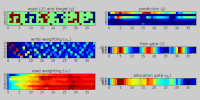GPT-5
This article possibly contains unsourced predictions, speculative material, or accounts of events that might not occur. Information must be verifiable and based on reliable published sources. (Learn how and when to remove this template message) |
Generative Pre-trained Transformer 5 (GPT-5) is an unreleased multimodal large language model created by OpenAI, expected to be the fifth in its series of the OpenAI GPT foundation models. On July 18, 2023, OpenAI filed for the trademark “GPT-5” for classes 9 and 42.
| Developer(s) | OpenAI |
|---|---|
| Initial release | Upcoming |
| Engine | |
| Replaces | GPT-4 |
| Type | |
| License | Proprietary |
![]() Search GPT-5 on Amazon.
Search GPT-5 on Amazon.
| Part of a series on |
| Machine learning and data mining |
|---|
|
Problems |
|
Learning with humans |
|
Model diagnostics |
Background[edit]
OpenAI introduced the first GPT model (GPT-1) in 2018, publishing a paper called Improving Language Understanding by Generative Pre-Training.[1] It was based on the transformer architecture and trained on a large corpus of books.[2] In 2019, they introduced GPT-2, a larger model that could generate coherent text.[3]
In 2020, they introduced GPT-3, a model with 100 times as many parameters as GPT-2, that could perform various tasks with few examples.[4] GPT-3 was further improved into InstructGPT, which was used to create the chatbot product ChatGPT. ChatGPT now uses GPT-3.5 for free users and GPT-4, which was released on March 14, 2023, for Plus users.
GPT-4 partially or fully powers many applications, including but not limited to Microsoft Copilot, GitHub Copilot, Snapchat, Khan Academy, and Duolingo.[5]
Timeline[edit]
3/8/2023: OpenAI releases GPT-4, its most powerful language model to date.
April 14, 2023: OpenAI CEO Sam Altman speaks at an event at MIT and confirms that the company is not currently training GPT-5. He says that OpenAI is "prioritizing GPT-4 development" and that "we are not and won't for some time" release GPT-5.[6]
July 18, 2023: OpenAI filed for the Trademark GPT-5 for classes 9 and 42. UPSTO serial number 98089548.[7][8][9]
November 13, 2023: Altman told the Financial Times that the company is now working to develop GPT-5[10][11]
Release date[edit]
There is no official release date for GPT-5 yet. Some sources suggested a release as early as 2023, but GPT-5 did not release that year.[12][13] A release in 2025 or later has also been speculated.[14][15][16]
Features[edit]
GPT-5 is expected to be a major improvement over GPT-4. Here is some information about the features of GPT-5:
Architecture[edit]
GPT-5 may use an advanced architecture that allows it to process and generate language more efficiently and accurately than previous versions. This architecture may include graph neural networks and attention mechanisms, which help the model to better understand the relationships between words and phrases.[17]
Artificial General Intelligence[edit]
GPT-5 may be able to achieve artificial general intelligence, the hypothetical level of intelligence which OpenAI defines as the ability to perform any economically valuable task that a human can. Some reports claimed that OpenAI expected GPT-5 to achieve AGI by the end of 2023.[18]
Challenges[edit]
Negative reputation[edit]
GPT-5 may face pushback from the tech community and the public, as some people fear the potential dangers and ethical issues of AI. Some notable personalities, such as Elon Musk and Steve Wozniak, have warned about the risks of AI and called for a pause on training models more advanced than GPT-4. They also suggested that tech giants should cooperate rather than compete in the AI field.[19]
Limited availability[edit]
GPT-5 may not be available to everyone, as OpenAI may limit its access to ChatGPT Plus subscribers and Bing Chat beta testers, which they have already done with GPT-4.[20]
References[edit]
- ↑ Radford, Alec; Narasimhan, Karthik; Salimans, Tim; Sutskever, Ilya (June 11, 2018). "Improving Language Understanding by Generative Pre-Training" (PDF). Archived from the original (PDF) on January 26, 2021. Retrieved April 3, 2023. Unknown parameter
|url-status=ignored (help) - ↑ Khandelwal, Umesh (April 1, 2023). "How Large Language GPT models evolved and work". Archived from the original on April 4, 2023. Retrieved April 3, 2023. Unknown parameter
|url-status=ignored (help) - ↑ "What is GPT-4 and Why Does it Matter?". April 3, 2023. Archived from the original on April 3, 2023. Retrieved April 3, 2023. Unknown parameter
|url-status=ignored (help) - ↑ Brown, Tom B. (July 20, 2020). "Language Models are Few-Shot Learners". arXiv:2005.14165v4 [cs.CL].
- ↑ Gupta, Aman (2023-03-21). "GPT-4 takes the world by storm - List of companies that integrated the chatbot". mint. Retrieved 2024-01-23.
- ↑ "OpenAI's Sam Altman Says There's No Chat GPT-5 to Worry About...Yet". April 14, 2023.
- ↑ USPTO GPT-5 Trademark Registration https://tmsearch.uspto.gov/bin/showfield?f=doc&state=4805:xgx403.2.1
- ↑ "OpenAI Drops Huge Clue About GPT-5".
- ↑ "GPT-5". March 17, 2023.
- ↑ Dorrier, Jason (2023-11-15). "OpenAI CEO Sam Altman Says His Company Is Now Building GPT-5". Singularity Hub. Retrieved 2024-01-23.
- ↑ "OpenAI chief seeks new Microsoft funds to build 'superintelligence'". www.ft.com. Retrieved 2024-01-23.
- ↑ "GPT-5: Release date, claims of AGI, pushback, and more". April 14, 2023.
- ↑ "GPT-5: Release date, rumors, and features we expect from ChatGPT 5". June 21, 2023.
- ↑ "Chat GPT-5 Release Date Prediction". April 24, 2023.
- ↑ "GPT-5 vs. GPT-4: What is the difference? GPT-5 Release Date". April 11, 2023.
- ↑ "ChatGPT-5 Release Date (Predictions)". March 23, 2023.
- ↑ "GPT-5: Release date, rumors, and features we expect from ChatGPT 5". June 21, 2023.
- ↑ "GPT-5 vs. GPT-4: What is the difference? GPT-5 Release Date". April 11, 2023.
- ↑ "GPT-5: Release date, claims of AGI, pushback, and more". April 14, 2023.
- ↑ "Introducing ChatGPT Plus".
This article "GPT-5" is from Wikipedia. The list of its authors can be seen in its historical and/or the page Edithistory:GPT-5. Articles copied from Draft Namespace on Wikipedia could be seen on the Draft Namespace of Wikipedia and not main one.

